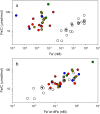Probing the Bioavailability of Dissolved Iron to Marine Eukaryotic Phytoplankton Using In Situ Single Cell Iron Quotas
- PMID: 35865367
- PMCID: PMC9286392
- DOI: 10.1029/2021GB006979
Probing the Bioavailability of Dissolved Iron to Marine Eukaryotic Phytoplankton Using In Situ Single Cell Iron Quotas
Abstract
We present a new approach for quantifying the bioavailability of dissolved iron (dFe) to oceanic phytoplankton. Bioavailability is defined using an uptake rate constant (kin-app) computed by combining data on: (a) Fe content of individual in situ phytoplankton cells; (b) concurrently determined seawater dFe concentrations; and (c) growth rates estimated from the PISCES model. We examined 930 phytoplankton cells, collected between 2002 and 2016 from 45 surface stations during 11 research cruises. This approach is only valid for cells that have upregulated their high-affinity Fe uptake system, so data were screened, yielding 560 single cell k in-app values from 31 low-Fe stations. We normalized k in-app to cell surface area (S.A.) to account for cell-size differences. The resulting bioavailability proxy (k in-app/S.A.) varies among cells, but all values are within bioavailability limits predicted from defined Fe complexes. In situ dFe bioavailability is higher than model Fe-siderophore complexes and often approaches that of highly available inorganic Fe'. Station averaged k in-app/S.A. are also variable but show no systematic changes across location, temperature, dFe, and phytoplankton taxa. Given the relative consistency of k in-app/S.A. among stations (ca. five-fold variation), we computed a grand-averaged dFe availability, which upon normalization to cell carbon (C) yields k in-app/C of 42,200 ± 11,000 L mol C-1 d-1. We utilize k in-app/C to calculate dFe uptake rates and residence times in low Fe oceanic regions. Finally, we demonstrate the applicability of k in-app/C for constraining Fe uptake rates in earth system models, such as those predicting climate mediated changes in net primary production in the Fe-limited Equatorial Pacific.
Keywords: iron bioavailability; iron limited phytoplankton; iron uptake rates; single cell iron quota; standardized proxy for availability.
© 2021. The Authors.
Conflict of interest statement
The authors declare no conflicts of interest relevant to this study.
Figures








Similar articles
-
Insights into the bioavailability of oceanic dissolved Fe from phytoplankton uptake kinetics.ISME J. 2020 May;14(5):1182-1193. doi: 10.1038/s41396-020-0597-3. Epub 2020 Feb 5. ISME J. 2020. PMID: 32024947 Free PMC article.
-
Iron bioavailability to phytoplankton: an empirical approach.ISME J. 2015 Mar 17;9(4):1003-13. doi: 10.1038/ismej.2014.199. ISME J. 2015. PMID: 25350155 Free PMC article.
-
Distinct iron cycling in a Southern Ocean eddy.Nat Commun. 2020 Feb 11;11(1):825. doi: 10.1038/s41467-020-14464-0. Nat Commun. 2020. PMID: 32047154 Free PMC article.
-
Towards the development of a new generation of whole-cell bioreporters to sense iron bioavailability in oceanic systems-learning from the case of Synechococcus sp. PCC7002 iron bioreporter.J Appl Microbiol. 2019 Nov;127(5):1291-1304. doi: 10.1111/jam.14277. Epub 2019 Jun 26. J Appl Microbiol. 2019. PMID: 30970168 Review.
-
Iron Uptake Mechanisms in Marine Phytoplankton.Front Microbiol. 2020 Nov 5;11:566691. doi: 10.3389/fmicb.2020.566691. eCollection 2020. Front Microbiol. 2020. PMID: 33250865 Free PMC article. Review.
Cited by
-
Synechococcus nitrogen gene loss in iron-limited ocean regions.ISME Commun. 2023 Oct 2;3(1):107. doi: 10.1038/s43705-023-00314-9. ISME Commun. 2023. PMID: 37783796 Free PMC article.
-
Chasing iron bioavailability in the Southern Ocean: Insights from Phaeocystis antarctica and iron speciation.Sci Adv. 2023 Jun 28;9(26):eadf9696. doi: 10.1126/sciadv.adf9696. Epub 2023 Jun 28. Sci Adv. 2023. PMID: 37379397 Free PMC article.
-
Microbial competition for iron determines its availability to the ferrous wheel.ISME J. 2025 Jan 2;19(1):wraf015. doi: 10.1093/ismejo/wraf015. ISME J. 2025. PMID: 39869783 Free PMC article.
-
Assessing the contribution of diazotrophs to microbial Fe uptake using a group specific approach in the Western Tropical South Pacific Ocean.ISME Commun. 2022 Apr 27;2(1):41. doi: 10.1038/s43705-022-00122-7. ISME Commun. 2022. PMID: 37938297 Free PMC article.
References
-
- Allen, A. E. , LaRoche, J. , Maheswari, U. , Lommer, M. , Schauer, N. , Lopez, P. J. , & Bowler, C. (2008). Whole‐cell response of the pennate diatom Phaeodactylum tricornutum to iron starvation. Proceedings of the National Academy of Sciences of the USA, 105(30), 10438–10443. 10.1073/pnas.0711370105 - DOI - PMC - PubMed
-
- Aumont, O. , Ethé, C. , Tagliabue, A. , Bopp, L. , & Gehlen, M. (2015). PISCES‐v2: An ocean biogeochemical model for carbon and ecosystem studies. Geoscientific Model Development, 8(8), 2465–2513. 10.5194/gmd-8-2465-2015 - DOI
-
- Baer, S. E. , Rauschenberg, S. , Garcia, C. A. , Garcia, N. S. , Martiny, A. C. , Twining, B. S. , & Lomas, M. W. (2019). Carbon and nitrogen productivity during spring in the oligotrophic Indian Ocean along the GO‐SHIP IO9N transect. Deep‐Sea Research Part II: Topical Studies in Oceanography, 161. 10.1016/j.dsr2.2018.11.008 - DOI
LinkOut - more resources
Full Text Sources
